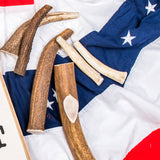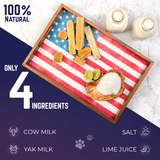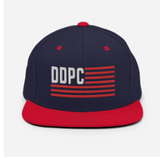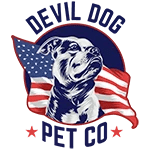Key Takeaways
- Puppy freezer teething toys are designed to provide cold relief for sore gums during the teething phase.
- The cold temperature helps numb pain and reduce inflammation in puppies' gums.
- These toys help redirect destructive chewing behavior in puppies.
- The teething phase typically occurs between 4 to 6 months of age.
- Using freezer teething toys promotes both relief and safety for teething puppies.
Table of Contents
- The Ultimate Guide to Puppy Freezer Teething Toys: Relief, Safety, and Smart Choices
- What Are Puppy Freezer Teething Toys? Functions & Key Benefits
- How Cold Relieves Puppy Teething Pain: The Science & Best Practices
- Types of Puppy Freezer Teething Toys: Materials & Designs
- How to Use and Maintain Puppy Freezer Teething Toys Safely
- DIY Puppy Freezer Teething Toys: Simple, Safe Recipes
- Store-Bought vs. Homemade: Making the Right Choice
- Selecting the Perfect Puppy Freezer Teething Toy
- Top-Rated Puppy Freezer Teething Toys: What the Pros & Owners Recommend
- Freezer Puppy Teething Toys vs. Popular Alternatives: A Detailed Comparison
- Troubleshooting Puppy Freezer Teething Toy Challenges: Real Solutions
What Are Puppy Freezer Teething Toys? Functions & Key Benefits

Freezer teething toys are chews intentionally designed for freezing, crafted from safe, non-toxic materials that become cold and soothing. Unlike regular toys, these provide dual benefits: sensory comfort plus mental enrichment through extended chewing sessions.
Key features include chew-resistant construction, appropriate sizing to prevent choking, and often fillable wells for treats or broth. The health benefits are immediate:
For puppies that need extra relief, frozen yak chews offer a long-lasting, edible option that soothes gums and keeps your pup engaged.
- Soothe inflamed gums and slow obsessive biting
- Reduce destructive chewing on furniture and personal items
- Improve mental focus and stress management
- Gentle cold therapy helps minor gum irritation per veterinary guidance
The science is simple: cold therapy numbs nerve endings while providing safe, supervised chewing outlets during the most challenging teething phase.
If your puppy is a determined chewer, consider rotating in braided bully sticks from the freezer for added durability and flavor variety.
How Cold Relieves Puppy Teething Pain: The Science & Best Practices
During the 4-6 month teething window, baby teeth fall out as adult teeth erupt through inflamed, sore gums. According to the American Veterinary Dental College, cold therapy numbs nerve endings, constricts blood vessels, and reduces swelling, the same principle used in human sports medicine, making chilled chew toys or treats that are edible for dogs both soothing and safe.
A 20-minute session with a frozen chew can reduce visible gum swelling in most puppies. The optimal protocol: 10-20 minutes per session, 2-3 times daily, with room-temperature chews rotated between cold sessions to prevent over-chilling small puppy jaws.
Freezable teething toys for puppies work because they maintain therapeutic cold longer than ice cubes while providing safe chewing resistance. The key is controlled exposure, enough cold for relief without numbing the entire mouth.
Types of Puppy Freezer Teething Toys: Materials & Designs
| Toy Type | Material | Key Features | Best For | Durability |
|---|---|---|---|---|
| Soft Rubber | Food-grade rubber | Fillable wells, textured nubs | Light to moderate chewers | Medium |
| Silicone | Non-toxic silicone | Bendable, easy cleaning | Gentle teethers, easy maintenance | Medium |
| Rope/Fabric | Cotton or fleece | Knots hold cold, washable | Budget-conscious, DIY options | Low |
| Edible Chews | Yak cheese, bully stick | Fully consumable, nutritious | Power chewers, maximum engagement | Single-use |
Flavor infusions like peanut butter or bacon help maintain puppy interest while building positive chewing associations. Interactive features include color-changing elements and bristle textures that massage gums during use.
For serious teething relief, edible puppy chew toys for teething like frozen yak chews provide the longest-lasting engagement while delivering essential minerals.
How to Use and Maintain Puppy Freezer Teething Toys Safely

Step-by-step setup:
- Select proper size, toy must be longer than puppy's muzzle, never small enough to fit between back molars
- Rinse thoroughly, fill with water or low-sodium broth if applicable
- Freeze for 2+ hours until completely chilled
- Offer for 10-20 minutes under supervision
- Collect, rinse, inspect for damage, re-freeze
Pro tips for safe freezer teething toy use:
- Rotate 2-3 toys daily to maintain novelty and hygiene
- Use during crate time for calm-down sessions, not rough play
- Size up when in doubt - bigger is always safer than too small
Veteran Tip: Never refreeze a toy with visible cracks or deep bite marks. A compromised toy can break apart and create choking hazards.
Maintenance routine: Wash with warm, soapy water after each use. Air dry completely before refreezing. Inspect weekly for damage - retire any toy showing wear that could create loose pieces.
For more tips on keeping your home safe during the teething phase, check out puppy proofing your home for fall.
DIY Puppy Freezer Teething Toys: Simple, Safe Recipes
Budget-conscious owners can create effective puppy freezer teething toys using household items. These homemade options work well for emergency relief or testing your pup's preferences, especially if you have Wavy Haired Dogs that may need extra soothing, before investing in commercial products.
Frozen Cloth Knot
Soak a clean, unbleached cotton washcloth in unsalted chicken broth for 5 minutes. Twist into tight knots and freeze for 2+ hours. Prep time: 3 minutes active, 2 hours freezing. Monitor closely for shredding and retire immediately if threads come loose.
Broth Ice Cube Pops
Fill ice cube trays with low-sodium bone broth or plain Greek yogurt mixed with tiny carrot bits. Freeze overnight. Perfect for 10-15 minute supervised sessions. Safety note: Use only puppy-safe ingredients - avoid artificial sweeteners or high-sodium broths.
Frozen Yak Chew Enhancement
Take a Devil Dog yak chew, dampen slightly with water, and freeze for 1-2 hours. The cold intensifies the natural flavor while providing extra gum relief. This method extends chew time and maximizes the soothing benefits of premium yak cheese.
When DIY works best: Testing puppy preferences, emergency situations, or supplementing commercial toys. Always prioritize safety over savings - inspect homemade toys more frequently than store-bought options.
Store-Bought vs. Homemade: Making the Right Choice
| Factor | Store-Bought | Homemade |
|---|---|---|
| Safety Testing | Third-party tested materials, proven durability | Depends on materials chosen, owner judgment |
| Durability | Engineered for repeated freeze cycles | Variable, often single-use |
| Cost Over Time | Higher upfront, lower per-use | Lower upfront, frequent replacement |
| Convenience | Ready to use, consistent results | Requires prep time, inconsistent |
| Customization | Limited flavor options | Full control over ingredients |
The verdict: Commercial puppy freezer teething toys offer superior safety and longevity for regular use. DIY options serve well as supplements or emergency solutions. Most successful owners use both - premium toys like Devil Dog yak chews for daily relief, homemade options for variety.
For power chewers or safety-conscious owners, invest in tested commercial products. The upfront cost pays off through durability and peace of mind.
If you're interested in learning more about the benefits of yak cheese for dogs, read our detailed guide on yak cheese.
Selecting the Perfect Puppy Freezer Teething Toy

The right puppy freezer teething toy matches your pup's age, chew drive, and temperament. Making the wrong choice wastes money and potentially creates safety risks.
Age and jaw development: Puppies 2-4 months need softer silicone or rubber options that won't stress developing teeth. Once adult teeth emerge (4+ months), firmer toys like frozen yak chews provide appropriate resistance without damage risk.
Chew drive assessment: Furniture destroyers require thick, long-lasting options - think Devil Dog yak chews or heavy-duty rubber toys. Light chewers succeed with softer materials or even frozen rope toys. Watch your pup's chewing style during the first few sessions to gauge intensity.
Size selection rules:
- Choose toys longer than your puppy's muzzle
- Ensure the toy cannot fit between back molars
- When in doubt, size up - bigger is always safer
Allergy considerations: Stick to single-ingredient options for sensitive pups. Yak chews work well for most food allergies, while rubber toys avoid common protein triggers.
Start with 15-minute supervised sessions. Monitor your puppy's energy level, gum condition, and stool consistency. Gradually increase time as your puppy adapts to the cold relief.
Top-Rated Puppy Freezer Teething Toys: What the Pros & Owners Recommend
| Product | Best For | Key Features | Price Range |
|---|---|---|---|
| Devil Dog Pet Co. Yak Chews (Frozen) | Power chewers, long-lasting relief | 100% digestible, naturally hard, freeze-ready | $8-15 |
| KONG Puppy Toy | Gentle chewers, fillable options | Soft rubber, dishwasher safe, pink color | $6-12 |
| Nylabone Puppy Chew | Moderate chewers, flavor variety | Chicken/peanut butter flavors, textured surface | $4-8 |
| Benebone Wishbone | Grip-focused chewing, bacon flavor | Curved design, real bacon infusion | $7-13 |
| Chilly Penguin Teether | Gentle relief, easy grip | Gel-filled, stays cold longer | $5-9 |
Veterinarians consistently recommend Devil Dog Pet Co.'s yak chews because they're completely digestible and naturally regulate chew intensity. Unlike synthetic toys that can crack teeth, yak chews soften slightly when frozen, providing optimal gum relief without jaw strain.
For more on developing good puppy habits beyond teething, see our article on puppy manners 101.
Devil Dog Pet Co. Yak Chews - Veteran-Proven Solution
Best for: Aggressive chewers, puppies with sensitive stomachs, owners wanting maximum value
These Himalayan yak chews transform into perfect puppy freezer teething toys when chilled for 2+ hours. The natural hardness numbs inflamed gums while the cold temperature reduces swelling. Unlike rubber alternatives, yak chews are completely edible, no choking hazards from torn pieces.
Marine veteran John Balcazar developed this line after watching Dexter destroy countless synthetic toys. The single-ingredient formula (yak milk, salt, lime juice) eliminates artificial additives that trigger puppy stomach upset.
Why It Stands Out: Only freezer teething solution that's 100% digestible. When your puppy outgrows teething, these chews continue providing dental benefits and mental stimulation through adulthood.
Freezer Puppy Teething Toys vs. Popular Alternatives: A Detailed Comparison
Smart owners compare all teething relief options before committing. Here's how puppy freezer teething toys stack against common alternatives:
Frozen Carrots: Natural and cheap, but create choking risks when puppies bite off chunks. Limited chew time before they become soggy.
Ice Cubes: Immediate cold relief but melt quickly and provide zero enrichment. Risk of tooth damage from hard ice.
Regular Teething Toys: Room temperature offers no anti-inflammatory benefits. Synthetic materials can harbor bacteria between uses.
Frozen Washcloths: Effective DIY option but require constant supervision. Fabric threads pose ingestion risks for determined chewers.
Puppy freezer teething toys combine the cold therapy benefits with safe, purpose-built materials. They maintain temperature longer than improvised solutions while eliminating the safety concerns of household items.
The key advantage: controlled relief. Unlike ice cubes that numb too aggressively or carrots that splinter unpredictably, quality freezer toys deliver consistent, measured comfort.
For a scientific perspective on teething and pain management, see this research article on cold therapy and inflammation.
Troubleshooting Puppy Freezer Teething Toy Challenges: Real Solutions

Puppy ignores frozen toy: Rub a small amount of low-sodium broth on the surface before freezing. The scent activation often triggers initial interest. Some puppies need parental modeling, hold the toy while they investigate.
Destroys toys too quickly: Size up immediately. A toy that fits entirely in your puppy's mouth won't provide adequate chew resistance. Switch to edible options like frozen yak chews that naturally regulate consumption speed.
Toy doesn't stay cold: Pre-chill for 4+ hours instead of the minimum 2. Wrap in a damp cloth before freezing to create an insulation layer that extends cold duration.
Swallows pieces: Remove any toy showing wear marks or loose fragments. Supervise every session, never leave a puppy unattended with any chew item, frozen or otherwise.
Still chews furniture: Freezer toys address teething discomfort but won't eliminate behavioral chewing. Increase crate training, limit access to target items, and redirect to appropriate chews consistently.
For additional teething and training advice, visit this authoritative veterinary resource on puppy teething and behavior.
Download the FREE 10-Step Dog Prep Guide
Frequently Asked Questions
How do puppy freezer teething toys help relieve pain and inflammation during the teething phase?
Puppy freezer teething toys provide cold therapy that numbs nerve endings and constricts blood vessels in inflamed gums, reducing pain and swelling. This soothing effect helps puppies manage discomfort while redirecting their chewing instincts to safe outlets.
What materials are commonly used in puppy freezer teething toys, and how do they differ in durability and safety?
Common materials include durable rubber, silicone, and non-toxic plastics designed to withstand chewing while safely retaining cold. Rubber and silicone offer chew resistance and flexibility, while plastics may be firmer but less durable; all should be free of harmful chemicals and sized appropriately to prevent choking.
What is the recommended usage protocol for freezer teething toys to ensure effective and safe cold therapy for puppies?
Freeze the toy for 1–2 hours before supervised use, limit chewing sessions to 15–20 minutes to avoid overexposure to cold, and clean the toy regularly to maintain hygiene. Always monitor your puppy to prevent chewing off and swallowing pieces.
Should I choose store-bought or homemade freezer teething toys, and what are the pros and cons of each option?
Store-bought toys are designed for durability, safety, and consistent cold retention, often featuring chew-resistant materials and treat wells. Homemade options can be cost-effective and customizable but may lack durability and safety testing, so they require careful ingredient selection and supervision.






